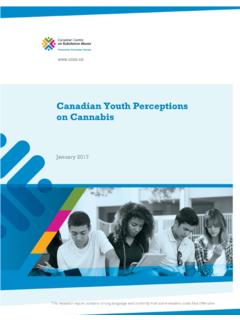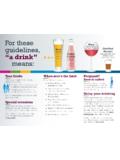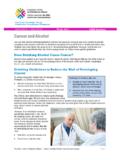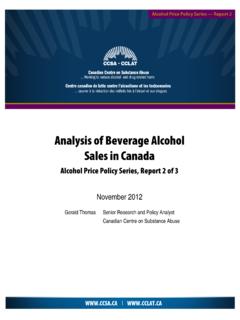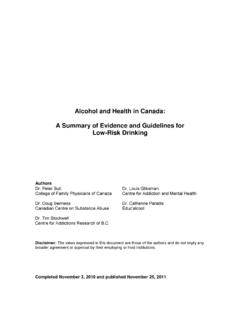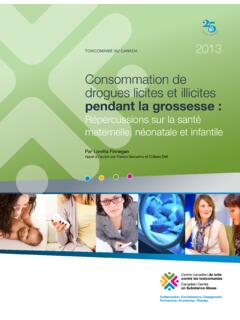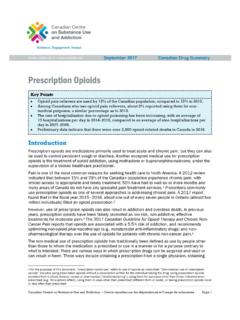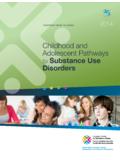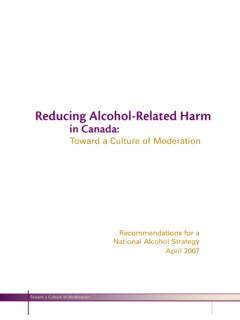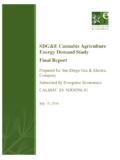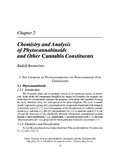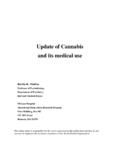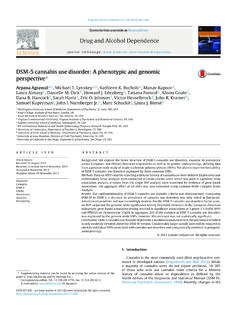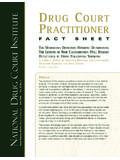Transcription of Clearing the Smoke on Cannabis - Canadian Centre …
1 Key Points Among young drivers, driving after using Cannabis is more prevalent than driving after drinking. Cannabis impairs the cognitive and motor abilities necessary to operate a motor vehicle and doubles the risk of crash involvement. After alcohol, Cannabis is the most commonly detected substance among drivers who die in traffic crashes. The police have the tools and authority required to detect and arrest drivers who are impaired by alcohol, Cannabis , also referred to as marijuana, is the most widely used psychoactive substance in Canada. According to the 2015 Canadian Tobacco, Alcohol and Drugs Survey (CTADS), of Canadians aged 15 years and older reported using Cannabis at least once in the past year (Statistics Canada, 2016), significantly higher than the in 2013. The use of Cannabis is generally more prevalent among youth, with of youth aged 15 to 19 and of young adults aged 20 to 24 reporting past-year use.
2 Approximately of Canadians aged 15 and older who used Cannabis in the past three months reported that they used this drug every day in 2012 (Health Canada, 2013).A growing body of evidence suggests that Cannabis use can negatively impact several aspects of people s lives, including mental and physical health, cognitive functioning, ability to drive a motor vehicle, and pre- and postnatal development among children (Volkow, Baler, Compton, & Weiss, 2014). This report one in a series reviewing the effects of Cannabis use on various aspects of human functioning and development (see McInnis & Plecas, 2016; Kalant & Porath-Waller, 2016; McInnis & Porath-Waller, 2016; Porath-Waller, 2015) provides an update on the topic of Cannabis use and theSmoke on CannabisCannabis Use and Driving An UpdateThis is the third in a series of reports that reviews the effects of Cannabis use on various aspects of human functioning and development.
3 This report on the effects of Cannabis use on driving provides an update of a previous report with new research findings that validate and extend our current understanding of this issue. Other reports in this series address the effects of chronic Cannabis use on cognitive functioning and mental health, maternal Cannabis use during pregnancy, and respiratory effects of Cannabis use. This series is intended for a broad audience, including health professionals, policy makers and J. Beirness, , Senior Research Associate, CCSA Amy J. Porath, , Director, Research and Policy, CCSA2 After over three decades of successful efforts to change behavior and to increase social intolerance of driving while impaired by alcohol, drug-impaired driving has emerged as an increasingly important public health and road safety issue. This report presents the evidence on the prevalence of driving following the use of Cannabis , the impact of Cannabis on driving performance and collision risk, and the detection of drivers who are impaired by this substance.
4 This report concludes by discussing implications for policy and practice. What is Drug-Impaired Driving?Drug-impaired driving refers to the operation of a motor vehicle while one s ability is adversely affected by a drug, including illegal drugs, prescription drugs, over-the-counter medications and volatile inhalants such as toluene or nitrous driving is a criminal offence in Canada. According to the Criminal Code (S. 253a), everyone commits an offence who operates a motor vehicle or .. has the care or control of a motor vehicle, .. whether it is in motion or not, while the person s ability to operate the vehicle .. is impaired by alcohol or a drug. The law applies to the operation of any type of motor vehicle, including snowmobiles, all-terrain vehicles (ATVs), boats, trains and airplanes. It also does not matter whether the vehicle is being operated on a public roadway or on private have the authority to demand a driver suspected of being under the influence of drugs to submit to a Standardized Field Sobriety Test (SFST), to participate in an evaluation of drug influence by an officer trained in the Drug Evaluation and Classification Program (known as a Drug Recognition Expert or DRE) and to provide a sample of blood, breath or oral fluid to determine the type and concentration of drugs in the drivers of Cannabis Use and DrivingData from the 2012 Canadian Alcohol and Drug Monitoring Survey (CADUMS) reveal that of drivers in Canada admitted driving within two hours of using Cannabis at least once in the previous 12 months (Health Canada, 2013).
5 This represents an estimated 632,576 persons who reported making million trips after using Cannabis , an average of approximately 16 trips per person per year. This compares with million persons ( of all drivers) who made an estimated million trips after consuming two or more drinks in the previous hour, an average of trips per persons per reported prevalence of driving after using Cannabis was higher among young people and males (Health Canada, 2013). Drivers aged 18 19 were most likely to report driving after using Cannabis ( ), followed by those aged 15 17 ( ). Males were three times more likely than females to drive after Cannabis the Smoke on Cannabis : Cannabis Use and Driving On April 13, 2017, the Government of Canada introduced legislation to amend the Criminal Code of Canada to strengthen the laws on impaired driving and introduce new provisions for dealing with drug use by drivers (Bill C-46; Government of Canada, 2017).
6 The new law would give police the authority to require a driver suspected of drug use to provide a sample of oral fluid to test for the presence of drugs, similar to the current approach for alcohol screening at roadside using approved devices. In addition, limits would be established for the presence of certain drugs. For Cannabis , a blood THC concentration of two ng/ml but less than five ng/ml would be a lower offence; a concentration of five ng/ml or more would be a more severe offence. Obtaining blood samples for analysis would be facilitated by allowing qualifying technicians to draw blood samples without a physician s oversight. The SFST consists of a set of three tests: walk-and-turn, one-leg stand, and an examination of eye movements known as nystagmus. This set of tests provides validated evidence of impairment and is widely used throughout the United Drug Evaluation and Classification assessment involves a systematic and standardized 12-step procedure to assess the common effects associated with various classes of drugs.
7 It concludes with the demand for a sample of blood, urine or oral fluid for toxicological testing for drug content. Refusal to comply with any of these demands is a Criminal Code offence with penalties that are equivalent to those for an impaired driving is a tobacco-like greenish or brownish material consisting of the dried flowering, fruiting tops and leaves of the Cannabis plant, Cannabis sativa. Hashish or Cannabis resin is the dried brown or black resinous secretion of the flowering tops of the Cannabis plant. The acute effects of Cannabis include euphoria and relaxation, changes in perception, time distortion, deficits in attention span and memory, body tremors, and impaired motor functioning. It is a controlled substance under the Controlled Drugs and Substances Act meaning that the acts of growing, possessing, distributing and selling Cannabis are illegal. There is an exception for those possessing Cannabis for medical purposes as supported by a CADUMS data reveal that riding as a passenger in a vehicle with a driver who has used Cannabis is a common behaviour as well, particularly among young Canadians.
8 Whereas 6 8% of youth reported driving after using Cannabis , reported having been a passenger with a driver who had smoked Cannabis within the previous two hours (Beirness, 2014). The prevalence of the behaviour decreases among young people who are beyond high school age. Nevertheless, these data indicate that the risks are not restricted to those who drive after using Cannabis but extend to those who choose to ride with these drivers as a roadside survey conducted in Ontario in 2014, oral fluid and breath samples were collected from a random sample of nighttime drivers. Overall, of drivers tested positive for drugs; Cannabis accounted for 75% of drug-positive cases. No young drivers ages 16 18 had been drinking, but tested positive for Cannabis (Beirness, Beasley, & McClaffery, 2015).After alcohol, Cannabis is the most commonly detected substance among drivers arrested for impaired driving.
9 In the United States, of more than 35,000 drug evaluations conducted on suspected impaired drivers in 2013, 30% involved Cannabis . In Canada, Cannabis and depressant drugs were the most frequently detected drugs in 2015 (International Association of Chiefs of Police, 2016). Cannabis use is not uncommon among drivers involved in collisions. In a study of seriously injured drivers admitted to a regional trauma unit in Toronto, tested positive for Cannabis (Stoduto, et al., 1993). An examination of fatally injured drivers in Canada between 2000 and 2010 revealed that of those tested were positive for Cannabis (Beirness, Beasley, & Boase, 2013). Four out of ten fatally injured drivers who had used Cannabis prior to the crash were between 16 and 24 years of age. It should be noted, however, that the data only indicate the presence of Cannabis and do not necessarily address the issue of driver of Cannabis on Driving PerformanceStudies have assessed the nature and extent of the effects of Cannabis on a wide variety of cognitive and motor tasks ( , Ashton, 2001; Berghaus & Guo, 1995; Hartman & Huestis, 2013; Ramaekers, Robbe, & O Hanlon, 2000).
10 Performance deficits have been found in tracking, reaction time, visual function, concentration, short-term memory, and divided attention. Studies of driving performance (both simulated and on-road) show increased variability in lateral position in the lane, following distance, and speed as a function of Cannabis use. Cannabis also impairs performance on divided attention tasks those tasks that require the ability to monitor and respond to more than one source of information at a time. Cannabis also compromised the ability to handle unexpected events, such as a pedestrian darting out on the roadway. Combining Cannabis with even small amounts of alcohol greatly increased the negative effects on driving skills (Downey, et al., 2013; Ramaekers, et al., 2000).Among the effects of Cannabis reported across various studies, a common finding is increased variability in performance.
